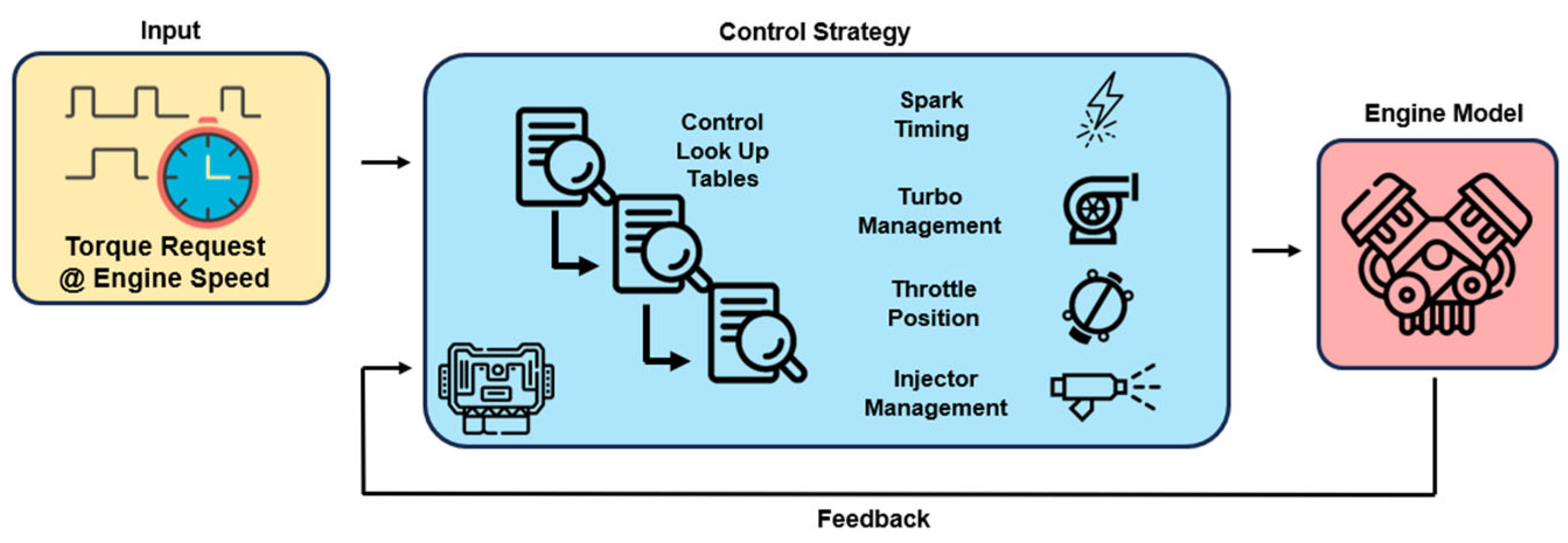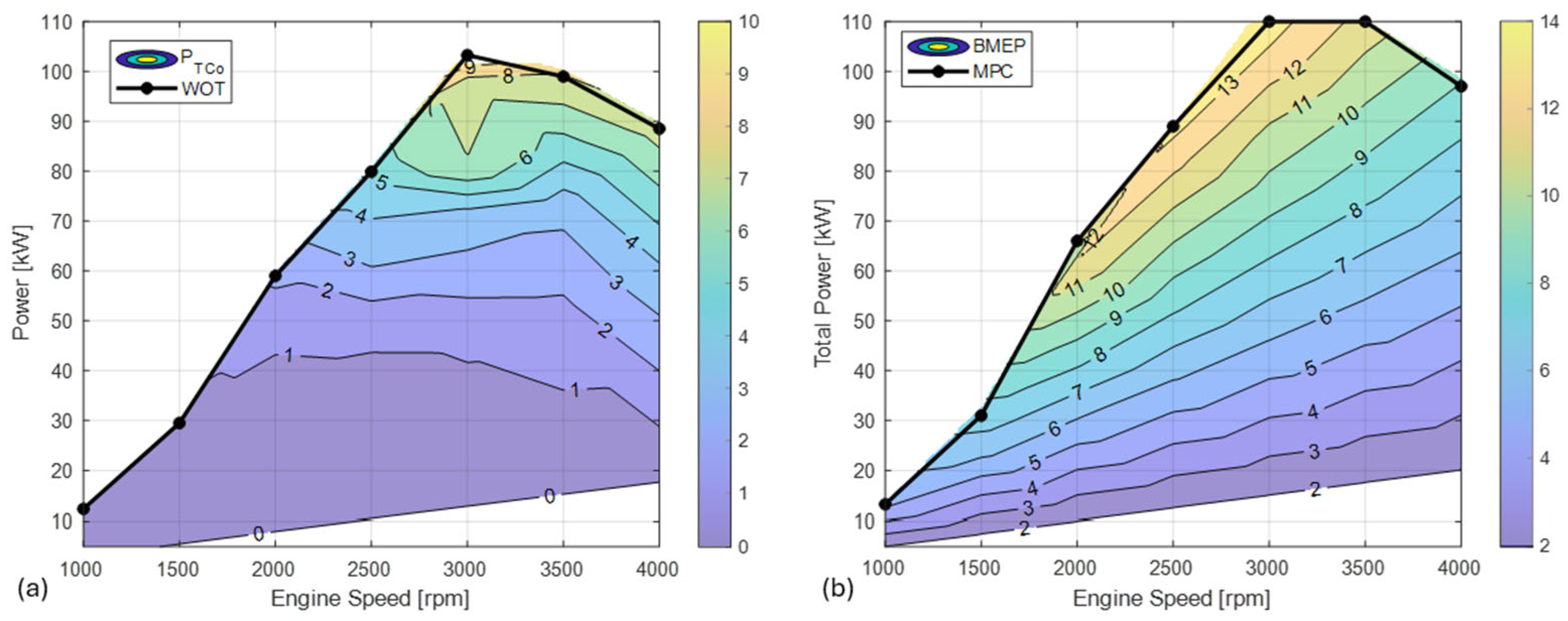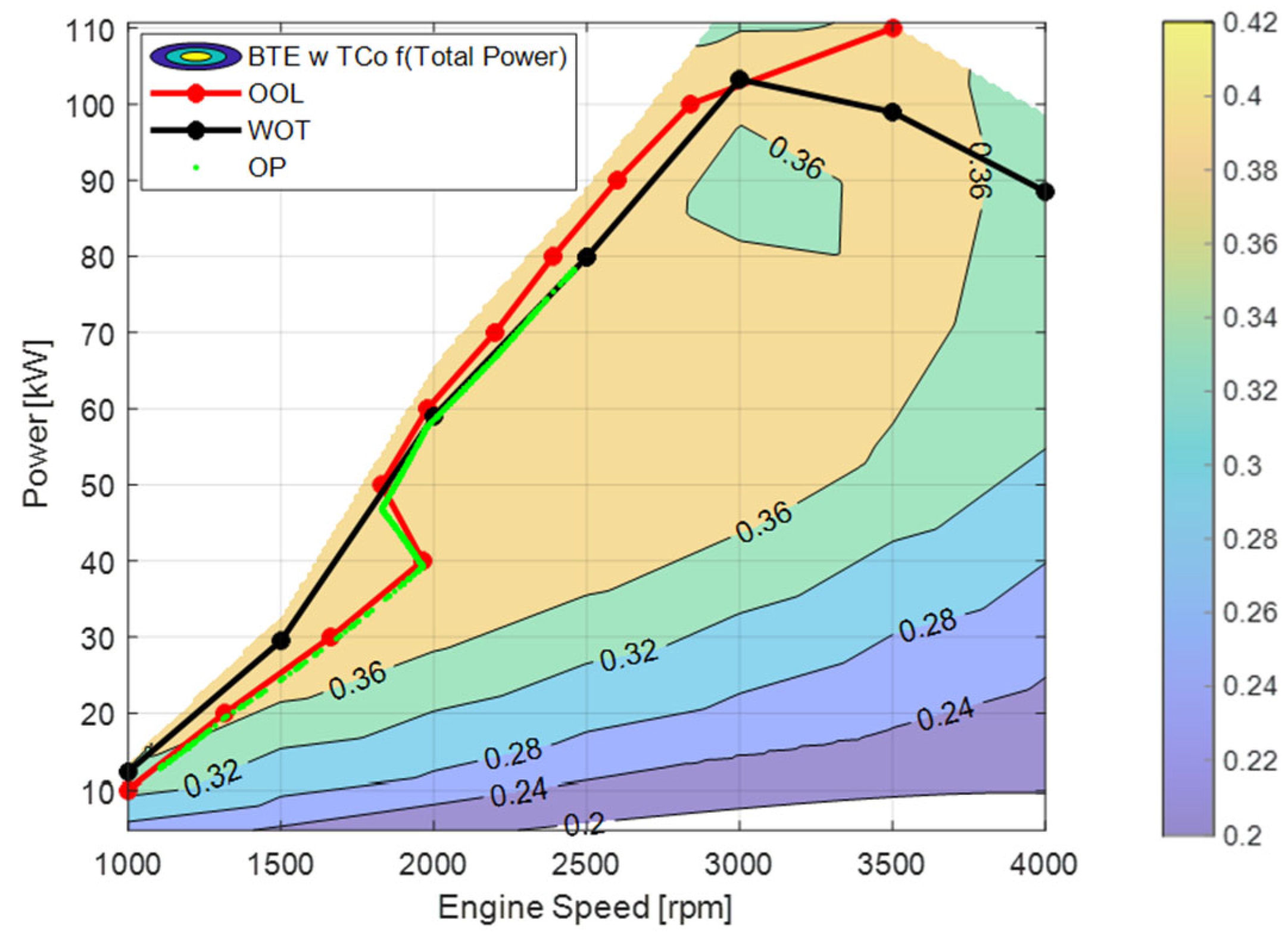Optimization of Hydrogen Internal Combustion Engines Equipped with Turbocompound Technology for Enhanced Performance and Efficiency
Abstract
1. Introduction
2. Materials and Methods
2.1. Engine and Turbocompound (TCo) Model
2.2. Combustion-Turbocompound Optimized Management
3. Results
4. Conclusions
Author Contributions
Funding
Data Availability Statement
Conflicts of Interest
Abbreviations
| AFT | Aftertreatment device |
| aTDC | After Top Dead Center |
| BEV | Battery Electric Vehicle |
| BMEP | Brake Mean Effective Pressure |
| BSFC | Brake Specific Fuel Consumption |
| BTE | Brake Thermal Efficiency |
| BTE* | Corrected BTE |
| CA50 | Crank Angle where 50% of Energy is Released |
| EGR | Exhaust Gas Recirculation |
| FC | Fuel Cell |
| H2ICE | Hydrogen Internal Combustion Engine |
| J | Integral Performance Index |
| LHV | Lower Heating Value |
| MPC | Maximum Power Curve |
| OOL | Optimal Operating Line |
| OP | Operative Point |
| ORC | Organic Rankine Cycle |
| PEM-FC | Proton Exchange Membrane Fuel Cell |
| pexh | Exhaust Pressure |
| PFI | Port Fuel Injection |
| PICE | Power of Internal Combustion Engine |
| PMP | Pontryagin Minimum Principle |
| PTCo | Power of the Turbocompound |
| SCR | Selective Catalyst Reduction |
| Texh | Exhaust Temperature |
| TCo | Turbocompound |
| VGT | Variable Geometry Turbine |
| WHR | Waste Heat Recovery |
| WOT | Wide Opened Throttle |
| λ | Air-to-Hydrogen Normalized Ratio |
| Hydrogen Mass Flow Rate | |
| Exhaust Mass Flow Rate | |
| ηTCO | Turbocompound Efficiency |
References
- European Green Deal—Consilium. Available online: https://www.consilium.europa.eu/en/policies/green-deal/ (accessed on 12 February 2024).
- Transport and Mobility. Available online: https://www.eea.europa.eu/en/topics/in-depth/transport-and-mobility (accessed on 7 November 2024).
- Manzetti, S.; Mariasiu, F. Electric vehicle battery technologies: From present state to future systems. Renew. Sustain. Energy Rev. 2015, 51, 1004–1012. [Google Scholar] [CrossRef]
- Giuliano, G.; Dessouky, M.; Dexter, S.; Fang, J.; Hu, S.; Miller, M. Heavy-duty trucks: The challenge of getting to zero. Transp. Res. Part D Transp. Environ. 2021, 93, 102742. [Google Scholar] [CrossRef]
- Sadeq, A. Alternative Fuels for Sustainable Combustion. 2024. Available online: https://www.researchgate.net/publication/382547111_Alternative_Fuels_for_Sustainable_Combustion (accessed on 10 January 2025).
- Ahluwalia, R.K.; Wang, X. Fuel cell systems for transportation: Status and trends. J. Power Sources 2008, 177, 167–176. [Google Scholar] [CrossRef]
- Arsie, I.; Battistoni, M.; Brancaleoni, P.P.; Cipollone, R.; Corti, E.; Di Battista, D.; Millo, F.; Occhicone, A.; Paradisi, B.P.; Rolando, L.; et al. A New Generation of Hydrogen-Fueled Hybrid Propulsion Systems for the Urban Mobility of the Future. Energies 2023, 17, 34. [Google Scholar] [CrossRef]
- Boretti, A. Hydrogen internal combustion engines to 2030. Int. J. Hydrogen Energy 2020, 45, 23692–23703. [Google Scholar] [CrossRef]
- Chai, W.S.; Bao, Y.; Jin, P.; Tang, G.; Zhou, L. A review on ammonia, ammonia-hydrogen and ammonia-methane fuels. Renew. Sustain. Energy Rev. 2021, 147, 111254. [Google Scholar] [CrossRef]
- Zuo, Q.; Yang, D.; Shen, Z.; Chen, W.; Lu, C.; Chen, L.; Lei, S. Effect of premixed ratio on combustion and emission characteristics in a spark ignition engine with hydrogen-ammonia direct injection. Fuel 2025, 393, 135051. [Google Scholar] [CrossRef]
- Acar, C.; Dincer, I. The potential role of hydrogen as a sustainable transportation fuel to combat global warming. Int. J. Hydrogen Energy 2020, 45, 3396–3406. [Google Scholar] [CrossRef]
- What are eFuels?—eFuel Alliance. Available online: https://www.efuel-alliance.eu/efuels/what-are-efuels (accessed on 1 July 2024).
- Brancaleoni, P.P.; Ferretti, A.N.D.; Corti, E.; Ravaglioli, V.; Moro, D. Next-Gen Italian Urban Mobility: Emissions LCA and TCO Prospective for Innovative Transportation Solutions’, SAE International, Warrendale, PA, SAE Technical Paper 2025-01–8593, April 2025. Available online: https://www.sae.org/publications/technical-papers/content/2025-01-8593/ (accessed on 24 March 2025).
- Brancaleoni, P.P.; Ferretti, A.N.D.; Corti, E.; Ravaglioli, V.; Moro, D. Lifecycle CO2 analysis for urban emission reduction of hydrogen-fuelled and battery electric buses in the European Union current and future energetic scenarios. Int. J. Hydrogen Energy 2025, 123, 335–353. [Google Scholar] [CrossRef]
- Bar-On, I.; Kirchain, R.; Roth, R. Technical cost analysis for PEM fuel cells. J. Power Sources 2002, 109, 71–75. [Google Scholar] [CrossRef]
- Barbir, F. PEM Fuel Cells: Theory and Practice, 2nd ed.; Elsevier: Amsterdam, The Netherlands; Academic Press: Boston, MA, USA, 2013. [Google Scholar]
- Aggarwal, A.; Yadav, S.; Singh, K.; Verma, A.S.; Chhabra, S. Study of utilization of hydrogen as fuel in internal combustion engine. Mater. Today: Proc. 2022, 64, 1211–1216. [Google Scholar] [CrossRef]
- Shinde, B.J.; Karunamurthy, K. Recent progress in hydrogen fuelled internal combustion engine (H2ICE)—A comprehensive outlook. Mater. Today Proc. 2021, 51, 1568–1579. [Google Scholar] [CrossRef]
- Di Vece, G.; Di Nunno, D.; Bilancia, M.; Verdino, V. Development of a Total Cost of Ownership Model to Compare BEVs, FCEVs and Diesel Powertrains on Bus Applications. In Proceedings of the CO2 Reduction for Transportation Systems Conference, SAE Technical Paper 2022-37-0030, Turin, Italy, 21–22 June 2022. [Google Scholar] [CrossRef]
- Raser, B.A. Total Cost of Ownership (TCO) Analysis for Heavy Duty Hydrogen Fueled Powertrains; Westport Fuel Systems: Vancouver, BC, Canada; AVL List GmbH: Graz, Austria, 2021. [Google Scholar]
- Brancaleoni, P.P.; Corti, E.; Ravaglioli, V.; Moro, D.; Silvagni, G.; Brusa, A.; Cavina, N.; Ponti, F. Performance Evaluation of Hydrogen-Powered Internal Combustion Engine City Bus for the Urban Mobility of Bologna, Italy. J. Phys. Conf. Ser. 2024, 2893, 012068. [Google Scholar] [CrossRef]
- Onori, S.; Serrao, L.; Rizzoni, G. Hybrid Electric Vehicles; Springer: London, UK, 2016. [Google Scholar] [CrossRef]
- Analysis of Energy Conversion Efficiency in Parallel and Series Hybrid Powertrains. Available online: https://ieeexplore.ieee.org/abstract/document/4356917 (accessed on 18 June 2024).
- Babayev, R.; Im, H.G.; Andersson, A.; Johansson, B. Hydrogen double compression-expansion engine (H2DCEE): A sustainable internal combustion engine with 60%+ brake thermal efficiency potential at 45 bar BMEP. Energy Convers. Manag. 2022, 264, 115698. [Google Scholar] [CrossRef]
- Boretti, A. High-efficiency internal combustion engine for hybrid hydrogen-electric locomotives. Int. J. Hydrogen Energy 2022, 48, 1596–1601. [Google Scholar] [CrossRef]
- Overview of Hydrogen Internal Combustion Engine (H2ICE) Technologies. Available online: https://hydrogen.energy.gov (accessed on 20 March 2025).
- Hamada, A.T.; Orhan, M.F. An overview of regenerative braking systems. J. Energy Storage 2022, 52, 105033. [Google Scholar] [CrossRef]
- Aghaali, H.; Ångström, H.-E. A review of turbocompounding as a waste heat recovery system for internal combustion engines. Renew. Sustain. Energy Rev. 2015, 49, 813–824. [Google Scholar] [CrossRef]
- Kozak, D.; Mazuro, P. Review of Small Gas Turbine Engines and Their Adaptation for Automotive Waste Heat Recovery Systems. Int. J. Turbomach. Propuls. Power 2020, 5, 8. [Google Scholar] [CrossRef]
- Pipitone, E.; Caltabellotta, S. Efficiency Advantages of the Separated Electric Compound Propulsion System for CNG Hybrid Vehicles. Energies 2021, 14, 8481. [Google Scholar] [CrossRef]
- Kruiswyk, R. The role of turbocompound in the era of emissions reduction. In Proceedings of the 10th International Conference on Turbochargers and Turbocharging, London, UK, 15–16 May 2012; IMechE, Ed.; Woodhead Publishing: London, UK, 2012; pp. 269–280. [Google Scholar] [CrossRef]
- Lu, P.; Brace, C.; Hu, B. Explore and Extend the Effectiveness of Turbo-Compounding in a 2.0 Litres Gasoline Engine (Second Report: Fuel Economy under Part Load Condition, Transient Performance and Effect of Pressure Ratio). In Proceedings of the SAE 2016 World Congress and Exhibition, SAE International, Detroit, MI, USA, 5 April 2016. [Google Scholar] [CrossRef]
- Joshi, S.; Dahodwala, M.; Koehler, E.W.; Franke, M.; Tomazic, D.; Naber, J. Novel Approach to Integration of Turbocompounding, Electrification and Supercharging Through Use of Planetary Gear System. In Proceedings of the SAE International, Warrendale, PA, USA, 3 April 2018. SAE Technical Paper 2018-01–0887.. [Google Scholar] [CrossRef]
- Katsanos, C.; Hountalas, D.; Zannis, T. Simulation of a heavy-duty diesel engine with electrical turbocompounding system using operating charts for turbocharger components and power turbine. Energy Convers. Manag. 2013, 76, 712–724. [Google Scholar] [CrossRef]
- Leng, L.; Cheng, J.; Shi, L.; Deng, K. Thermodynamic analysis on the effect of altitude on the exhaust energy recovery of electric turbocompound engines. Proc. Inst. Mech. Eng. Part D J. Automob. Eng. 2024, 239, 535–547. [Google Scholar] [CrossRef]
- Ma, Z.; Zhang, K.; Xiang, H.; Gu, J.; Yang, M.; Deng, K. Experimental study on influence of high exhaust backpressure on diesel engine performance via energy and exergy analysis. Energy 2022, 263, 125788. [Google Scholar] [CrossRef]
- Effects of an ORC Based Heat Recovery System on the Performances of a Diesel Engine—Technical Paper. Available online: https://saemobilus.sae.org/papers/effects-orc-based-heat-recovery-system-performances-a-diesel-engine-2015-01-1608#citation (accessed on 16 April 2025).
- Carcasci, C.; Cheli, L.; Lubello, P.; Winchler, L. Off-Design Performances of an Organic Rankine Cycle for Waste Heat Recovery from Gas Turbines. Energies 2020, 13, 1105. [Google Scholar] [CrossRef]
- Wang, S.; Yuan, Z.; Yu, N. Off-design condition optimization of organic Rankine cycle based on genetic algorithm. Energy Built Environ. 2024, 5, 665–682. [Google Scholar] [CrossRef]
- Brancaleoni, P.P.; Corti, E.; Ravaglioli, V.; Moro, D.; Silvagni, G. Innovative torque-based control strategy for hydrogen internal combustion engine. Int. J. Hydrogen Energy 2024, 73, 203–220. [Google Scholar] [CrossRef]
- Heffel, J. NOx emission reduction in a hydrogen fueled internal combustion engine at 3000 rpm using exhaust gas recirculation. Int. J. Hydrogen Energy 2003, 28, 1285–1292. [Google Scholar] [CrossRef]
- Saravanan, N.; Nagarajan, G. An insight on hydrogen fuel injection techniques with SCR system for NOX reduction in a hydrogen–diesel dual fuel engine. Int. J. Hydrogen Energy 2009, 34, 9019–9032. [Google Scholar] [CrossRef]
- Fayaz, H.; Saidur, R.; Razali, N.; Anuar, F.; Saleman, A.; Islam, M. An overview of hydrogen as a vehicle fuel. Renew. Sustain. Energy Rev. 2012, 16, 5511–5528. [Google Scholar] [CrossRef]
- Cheng, Q.; Zhang, R.; Shi, Z.; Lin, J. Review of common hydrogen storage tanks and current manufacturing methods for aluminium alloy tank liners. Int. J. Light. Mater. Manuf. 2024, 7, 269–284. [Google Scholar] [CrossRef]
- Di Battista, D.; Di Bartolomeo, M.; Di Prospero, F.; Di Diomede, D.; Carapellucci, R.; Cipollone, R. Turbocompound energy recovery option on a turbocharged diesel engine. J. Phys. Conf. Ser. 2023, 2648, 012078. [Google Scholar] [CrossRef]
- Millo, F.; Piano, A.; Rolando, L.; Accurso, F.; Gullino, F.; Roggio, S.; Bianco, A.; Pesce, F.; Vassallo, A.; Rossi, R.; et al. Synergetic Application of Zero-, One-, and Three-Dimensional Computational Fluid Dynamics Approaches for Hydrogen-Fuelled Spark Ignition Engine Simulation. SAE Int. J. Engines 2021, 15, 561–580. [Google Scholar] [CrossRef]
- Harris, T.A.; Kotzalas, M.N. Advanced Concepts of Bearing Technology: Rolling Bearing Analysis; CRC Press: Boca Raton, FL, USA, 2006. [Google Scholar]
- Rosset, K.; Pajot, O.; Schiffmann, J. Experimental Investigation of a Small-Scale Organic Rankine Cycle Turbo-Generator Supported on Gas-Lubricated Bearings. J. Eng. Gas Turbines Power 2021, 143, 051015. [Google Scholar] [CrossRef]
- Wang, Y.; Xu, Z.; Zhang, C.; Liu, L. Combustion optimization of a hydrogen free-piston engine with high-energy ignition. Int. J. Hydrogen Energy 2023, 49, 483–494. [Google Scholar] [CrossRef]






| Parameter | Value |
|---|---|
| Engine Configuration | V6 |
| Engine Displacement [l] | 3.0 |
| Compression Ratio [/] | 12.85 |
| Injection System | Twin—Port Fuel Injection (PFI) |
| Exhaust Gas Recirculation (EGR) | High Pressure |
| Charging System | Single Stage Variable Geometry Turbine (VGT) |
| Parameter | Value | Step Size |
|---|---|---|
| Engine Speed [rpm] | 1000–4000 | 1000 |
| BMEP [bar] | 2–max @given engine speed | 2 |
| λ [/] | 2–2.75 | 0.25 |
| CA50 [°CA] | 0–30 | 5 |
| EGR [%] | 0–7.5 | 2.5 |
| TCo Speed [krpm] | 0–100 | 25 |
Disclaimer/Publisher’s Note: The statements, opinions and data contained in all publications are solely those of the individual author(s) and contributor(s) and not of MDPI and/or the editor(s). MDPI and/or the editor(s) disclaim responsibility for any injury to people or property resulting from any ideas, methods, instructions or products referred to in the content. |
© 2025 by the authors. Licensee MDPI, Basel, Switzerland. This article is an open access article distributed under the terms and conditions of the Creative Commons Attribution (CC BY) license (https://creativecommons.org/licenses/by/4.0/).
Share and Cite
Brancaleoni, P.P.; Corti, E.; Di Prospero, F.; Di Battista, D.; Cipollone, R.; Ravaglioli, V. Optimization of Hydrogen Internal Combustion Engines Equipped with Turbocompound Technology for Enhanced Performance and Efficiency. Energies 2025, 18, 2166. https://doi.org/10.3390/en18092166
Brancaleoni PP, Corti E, Di Prospero F, Di Battista D, Cipollone R, Ravaglioli V. Optimization of Hydrogen Internal Combustion Engines Equipped with Turbocompound Technology for Enhanced Performance and Efficiency. Energies. 2025; 18(9):2166. https://doi.org/10.3390/en18092166
Chicago/Turabian StyleBrancaleoni, Pier Paolo, Enrico Corti, Federico Di Prospero, Davide Di Battista, Roberto Cipollone, and Vittorio Ravaglioli. 2025. "Optimization of Hydrogen Internal Combustion Engines Equipped with Turbocompound Technology for Enhanced Performance and Efficiency" Energies 18, no. 9: 2166. https://doi.org/10.3390/en18092166
APA StyleBrancaleoni, P. P., Corti, E., Di Prospero, F., Di Battista, D., Cipollone, R., & Ravaglioli, V. (2025). Optimization of Hydrogen Internal Combustion Engines Equipped with Turbocompound Technology for Enhanced Performance and Efficiency. Energies, 18(9), 2166. https://doi.org/10.3390/en18092166








